columnist misha herbert.
For the first time in over a century, the portraits on the $20, $10 and $5 bills are going through a major overhaul. The space used exclusively for white former presidents and historical figures will now be occupied with a diverse and culturally-significant group of men and women.
Treasury Secretary Jacob Lew, who unveiled the changes on April 20, explained this momentous decision: “When I announced last June that a new redesign would feature a woman, I hoped to encourage a national conversation about women in our democracy.” He says the response to this redesign has been “powerful.”
The face of the $20 bill, which is currently claimed by 7th U.S. President Andrew Jackson, will soon feature Underground Railroad champion Harriet Tubman. Jackson, who will be moving to the back of the $20 bill, owned slaves and boasts the major legislative accomplishment of creating the act that led to the Trail of Tears, which forced thousands of Cherokees from their land.
Harriet Tubman, who escaped slavery as a young woman, has long-since been revered as a main “Conductor” of the Underground Railroad. She is triumphed for leading thousands of slaves to freedom through the network of tunnels that traveled from the south to the north. She also worked as a spy for the Union Army during the Civil War, and was the first American woman to lead a military expedition
The back of the $10 bill, where the Treasury building is currently printed, will undergo a redesign to commemorate a 1913 march that ended on the steps of that very building. This portrait will include women’s rights gamechangers Susan B. Anthony, Elizabeth Cady Stanton, Lucretia Mott, Alice Paul and Sojourner Truth.
cbsnews.com
This group of women, while often left out of the historical conversation, was imperative to the passing of the 19th Amendment, which granted women the right to vote.
According to Secretary Lew, the $5 bill will also undergo change: “The illustration of the Lincoln Memorial on the back will be redesigned to honor events at the Lincoln Memorial that helped to shape our history and our democracy.”
Where the Lincoln memorial is currently printed, we will soon see Dr. Martin Luther King, Jr, who gave his famous “I Have A Dream” speech on the steps of the monument in 1936; Marion Anderson, an African-American opera singer, who gave a concert at the memorial in 1939 after she had been blocked from singing at the then-segregated Constitution Hall; and Eleanor Roosevelt, who was an outspoken political activist and arranged Anderson’s concert despite the backlash from segregationists.
Gabe Bullard of National Geographic wrote, “We in the United States have been putting dead white statesmen on our coins for so long that it’s been unquestioned for some time now.”
But this redesign of our bills allows us to do just that: question who our idols are, and learn from them.
For any non-American visitor who enters our country, the faces they see on our money serve as the most thorough representation of our history they will likely see. It would do us well to also look at our currency through these fresh eyes. What did the people in these portraits do for our country? How did they help us grow into who we are as a nation today?
With the new redesign of the Federal Reserve Note, we are one step closer to commemorating our truthful history, and the people who helpedshape it for the better.





![[Both photos courtesy of sonoma.edu]
Ming-Ting Mike Lee stepped in as the new SSU president following Sakakis resignation in July 2022](https://sonomastatestar.com/wp-content/uploads/2024/04/CC4520AB-22A7-41B2-9F6F-2A2D5F76A28C-1200x1200.jpeg)




























